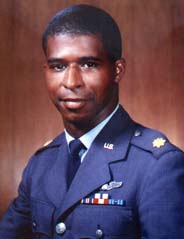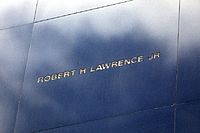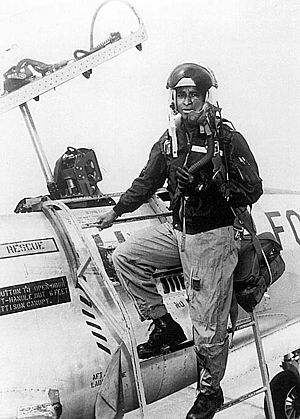Robert Henry Lawrence Jr. facts for kids
Quick facts for kids
Robert Henry Lawrence Jr.
|
|
|---|---|
 |
|
| Born | October 2, 1935 |
| Died | December 8, 1967 (aged 32) Edwards Air Force Base, California, U.S.
|
| Nationality | American |
| Alma mater | Bradley, BS 1956 Ohio State, PhD 1965 |
| Occupation | Test pilot |
| Space career | |
| USAF Astronaut | |
| Rank | |
|
Time in space
|
None |
| Selection | 1967 USAF MOL Group 3 |
| Missions | None |
|
Mission insignia
|
None |
Robert Henry Lawrence Jr. (born October 2, 1935 – died December 8, 1967) was an Air Force officer. He made history as the first African-American astronaut.
Contents
Early Life and Education
Robert Lawrence Jr. was born and grew up in Chicago, Illinois. He was a very bright student from a young age. At just sixteen years old, he finished Englewood High School in 1952. He was among the top 10 percent of his class.
In 1956, he earned a degree in Chemistry from Bradley University. While at Bradley, he was part of the Air Force ROTC program. He became a Cadet Commander and was made a second lieutenant in the Air Force Reserve.
Air Force Career
At 21, Robert Lawrence became a U.S. Air Force pilot. He completed his flight training at Malden Air Force Base in Missouri.
When he was 22, he married Barbara Cress. By the age of 25, he had worked as an instructor pilot. He taught pilots in Germany how to fly the T-33 training aircraft.
In 1965, Lawrence earned a PhD in physical chemistry from Ohio State University. This shows how dedicated he was to both flying and science.
He was a highly skilled senior USAF pilot. He flew for over 2,500 hours, with 2,000 of those hours in jets. Lawrence flew many tests in the Lockheed F-104 Starfighter. These tests helped study how unpowered spacecraft, like the North American X-15, would glide back to Earth from space. NASA recognized his work, saying his flight data helped a lot in developing the Space Shuttle.
Becoming an Astronaut
In June 1967, Lawrence finished the U.S. Air Force Test Pilot School in Edwards AFB, California. That same month, the Air Force chose him for their Manned Orbital Laboratory (MOL) program. This made him the country's first black astronaut.
When asked if his selection was a big step for race relations in the United States, Lawrence said it was a "normal progression." He felt he had been lucky to have opportunities. Donald H. Peterson, another astronaut chosen for MOL, said he was happy to work with Lawrence.

Tragic Death and Lasting Legacy
Sadly, Robert Lawrence died at age 32 in a plane crash. This happened at Edwards AFB on December 8, 1967. He was in the back seat of an F-104 jet. He was teaching another pilot, Major Harvey Royer, a special landing technique.
During the landing, the plane hit the ground very hard. It caught fire and skidded. Major Royer was able to eject and survived with serious injuries. However, Lawrence's ejection seat went sideways, killing him instantly.
If Lawrence had lived, he likely would have joined NASA's astronaut group after the MOL program was canceled. Many of those astronauts later flew on the Space Shuttle.
Even though his career was short, Lawrence received important awards. These include the Air Force Commendation Medal and the Outstanding Unit Citation. On December 8, 1997, his name was added to the Space Mirror Memorial at the Kennedy Space Center in Florida. This memorial honors astronauts who have died.
His legacy continues to be honored. The 13th Northrop Grumman Cygnus spacecraft, which launched in 2020, was named the S.S. Robert H. Lawrence in his honor.
An artist named Tavares Strachan dedicated his satellite sculpture, ENOCH, to Lawrence in 2018. In 2020, NASA named an asteroid after him, Robertlawrence 92892. This asteroid is located between Mars and Jupiter.
See also
 In Spanish: Robert Henry Lawrence Jr. para niños
In Spanish: Robert Henry Lawrence Jr. para niños


